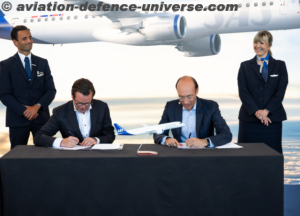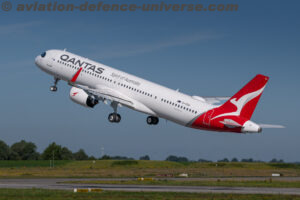- Record load factors support highest-ever half-year operating and net profits
- Growing competition, macroeconomic uncertainties, and inflationary cost pressures pose challenges to the airline industry going forward
- Interim dividend of 10 cents per share to be paid on 22 December 2023
SIA GROUP FINANCIAL PERFORMANCE
 First Half FY2023/24 – Profit and Loss
First Half FY2023/24 – Profit and Loss
The Singapore Airlines (SIA) Group financial performance for the first half FY2023/24 is summarised as follows:
| Group Financial Results | 1st Half
FY2023/24 ($ million) |
1st Half
FY2022/23 ($ million) |
Better/ (Worse)
(%) |
2nd Quarter
FY2023/24 ($ million) |
2nd Quarter
FY2022/23 ($ million) |
Better/ (Worse)
(%) |
| Total Revenue | 9,162 | 8,417 | 8.9 | 4,683 | 4,488 | 4.3 |
| Total Expenditure | 7,609 | 7,182 | (5.9) | 3,884 | 3,810 | (1.9) |
| Net Fuel Cost | 2,283 | 2,696 | 15.3 | 1,230 | 1,423 | 13.6 |
| Fuel Cost (before hedging) | 2,527 | 3,113 | 18.8 | 1,373 | 1,638 | 16.2 |
| Fuel Hedging Gain | (244) | (417) | (41.5) | (143) | (215) | (33.5) |
| Non-fuel Expenditure | 5,326 | 4,486 | (18.7) | 2,654 | 2,387 | (11.2) |
| Operating Profit | 1,554 | 1,234 | 25.9 | 799 | 678 | 17.8 |
| Net Profit | 1,441 | 927 | 55.4 | 707 | 557 | 26.9 |
The robust demand for air travel continued into the Northern Summer travel season, led by the rebound in passenger traffic to North Asia with the full reopening of China, Hong Kong SAR, Japan, and Taiwan. This resulted in record half-year operating and net profits for the SIA Group.
SIA and Scoot carried 17.4 million passengers in the first six months of FY2023/24, an increase of 52.3% year-on-year. Passenger traffic grew 38.0% from a year before, outpacing the capacity expansion of 29.0%. As a result, the Group passenger load factor (PLF) improved by 5.8 percentage points to 88.8%, the highest ever half yearly PLF. SIA and Scoot achieved record PLFs of 88.0% and 91.3% respectively.
The demand for air freight remained soft due to inventory overhang, as well as geopolitical and macroeconomic headwinds. The cargo load factor fell 8.4 percentage points to 52.7% year-on-year as cargo loads dipped 6.0%, while capacity grew 8.9% mainly due to increased passenger aircraft bellyhold space. Increased competition and softer demand also contributed to the downward pressure on cargo yields, which fell by 46.2% from a year before. Nevertheless, at 41.8 cents per load tonne-kilometre, cargo yields remained 37.0% above pre-pandemic levels1.
Group revenue rose $745 million (+8.9%) to $9,162 million, with the $1,571 million (+26.3%) increase in passenger flown revenue to $7,550 million partially offset by a $1,039 million (-49.5%) decline in cargo flown revenue to $1,060 million.
Expenditure increased by $427 million (+5.9%) to $7,609 million, with the rise in non-fuel expenditure of $840 million (+18.7%) partially offset by a $413 million decrease (-15.3%) in net fuel cost. Net fuel cost fell to $2,283 million mainly due to a 29.2% decrease in fuel prices (-$1,077 million), despite higher volume uplifted (+$566 million) and lower fuel hedging gain (+$173 million). The 18.7% increase in non-fuel expenditure was in-line with the 19.9% increase in overall passenger and cargo capacity.
Overall, the Group recorded an operating profit of $1,554 million, $320 million higher than a year before.
The Group posted a net profit of $1,441 million, $514 million more than the previous year (+55.4%), on the strong operating performance. The improvement in the bottom line was also aided by the net interest income versus net finance charges last year (+$222 million) and share of profits versus share of losses of associated companies last year (+$87 million), partially offset by a higher tax expense (-$118 million).
Second Quarter FY2023/24 – Profit and Loss
The Group posted a record quarterly operating profit of $799 million for the second quarter, an increase of $121 million (+17.8%) from last year, on the back of the strong demand over the peak summer season.
Group revenue rose $195 million (+4.3%) year-on-year to $4,683 million. Passenger flown revenue increased by $570 million (+17.3%) to $3,873 million, lifted by the 28.9% growth in traffic. Group PLF increased 2.0 percentage points to 88.6%, as traffic growth outpaced the increase in capacity (+26.0%). Cargo flown revenue dipped 48.3% or $484 million to $519 million due to a decline in yield (-48.0%) on weaker demand, coupled with the reinstatement of industry bellyhold cargo capacity. Nonetheless, cargo yields – at 39.2 cents per load tonne-kilometre – were 28.5% above pre-Covid levels1. Cargo loads remained flat year-on-year (-0.5%) while capacity increased 6.0%, resulting in a 3.5 percentage point drop in cargo load factor to 53.5%.
Group expenditure grew by $74 million (+1.9%) year-on-year to $3,884 million. This consisted of a $267 million increase (+11.2%) in non-fuel expenditure that was partially offset by a $193 million decrease (-13.6%) in net fuel cost. Net fuel cost fell to $1,230 million, mainly due to a 25.2% drop in fuel prices (-$478 million) that was partially offset by higher volume uplifted (+$262 million) and a lower fuel hedging gain (+$72 million). The increase in non-fuel expenditure was below the 17.0% increase in overall capacity including cargo.
The Group posted a second quarter net profit of $707 million, an increase of $150 million (+26.9%) from a year before. The improvement was mainly due to the better operating performance (+$121 million), a net interest income versus net finance charges last year (+$78 million), and a surplus on disposal of aircraft, spares, and spare engines (+$22 million), and partially offset by higher tax expense (-$56 million).
Balance Sheet
As of 30 September 2023, the Group shareholders’ equity was $17.3 billion, a decline of $2.5 billion from 31 March 2023. This was due to the redemption in June 2023 of half of the Mandatory Convertible Bonds (MCBs) that were issued in June 2021, which amounted to $3.4 billion. Total debt balances decreased by $0.7 billion to $14.7 billion, mainly due to the repayment of borrowings. Consequently, the Group’s debt-equity ratio increased from 0.77 times to 0.85 times.
Cash and bank balances saw a decrease of $2.8 billion to $13.5 billion, with the drop in cash balance arising from the redemption of the MCBs, repayment of borrowings, and payment of dividends. This was partially mitigated by the $2.6 billion of net cash generated from operations, which included proceeds from forward sales. In addition to the cash on hand, the Group retains access to $2.4 billion of committed lines of credit, all of which remain undrawn. The Group’s balance sheet remains healthy and is among the strongest in the industry.
FLEET DEVELOPMENT
SIA added three aircraft to its operating fleet in the second quarter. These comprise one Airbus A350-900 (delivered in July 2023) and two Boeing 787-10s (delivered in August 2023 and September 2023).
As of 30 September 2023, the Group’s operating fleet had 202 aircraft comprising 195 passenger aircraft and seven freighters. SIA’s operating fleet comprised 140 passenger aircraft2 and seven freighters, while Scoot had 55 passenger aircraft3. The Group has 96 aircraft4 on order.
With an average age of seven years and one month, the Group operates one of the youngest and most fuel-efficient fleets in the airline industry5. This allows its airlines to offer greater comfort and innovative products to customers, while further driving operating efficiency and supporting ongoing efforts to lower carbon emissions.
NETWORK DEVELOPMENT
During the second quarter, SIA reinstated services to Busan while Scoot resumed flights to Jinan, Nanchang, and Shenzhen. As of 30 September 2023, the Group’s passenger network6 covered 119 destinations in 36 countries and territories. SIA served 75 destinations while Scoot served 67 destinations. The cargo network comprised 124 destinations in 38 countries and territories.
In the Northern Winter operating season (29 October 2023 to 30 March 2024), SIA will re-introduce services to Chongqing (November 2023), Chengdu (December 2023), and Xiamen (between December 2023 and January 2024). As part of the regular review of the Group’s network, SIA will operate to Shenzhen in lieu of Scoot with the reinstatement of the full-service carrier’s flights from November 2023. SIA will also ramp up frequencies to Guangzhou from November 2023 from daily to double daily. Scoot will resume operations to Kunming and Changsha from November 2023. With these reinstatements, SIA and Scoot will serve 23 destinations in China compared to 25 points pre-pandemic7. In addition to the expansion in mainland China, Scoot will deploy supplementary services to Hong Kong SAR, Melbourne, and Sydney from December 2023 to February 2024 to cater to the year-end holiday demand.
For the Northern Summer 2024 operating season (31 March 2024 to 26 October 2024), SIA will ramp up services to destinations across its network. This includes restoring Airbus A380 services to Frankfurt, deploying widebody Airbus A350-900 medium-haul aircraft to Cairns and Male, and reinstating direct services between Singapore and Barcelona. Flight frequencies will be increased to reach or exceed pre-pandemic levels across multiple points. These include Ahmedabad (India), Beijing and Shanghai (China), Copenhagen (Denmark), Da Nang (Vietnam), Darwin, Melbourne, and Perth (Australia), Dubai (the United Arab Emirates), Tokyo-Haneda (Japan), and Seattle and Houston (the United States of America). SIA will launch four-times weekly direct flights between Singapore and Brussels in April 2024, subject to regulatory approvals.
SIA Group capacity is expected to reach an average of around 92% of pre-pandemic8 levels in December 2023. The Group expects to return to pre-Covid capacity levels within FY2024/25 with the progressive ramp-up of services across the network.
MULTI-HUB STRATEGY
The proposed merger of Air India and Vistara remains on course, with the Competition Commission of India approving the transaction in September 2023. It remains subject to foreign direct investment approval, as well as approvals from other regulators and competition authorities in several jurisdictions including those from India’s Directorate General of Civil Aviation, Ministry of Civil Aviation, and National Company Law Tribunal, and the Competition and Consumer Commission of Singapore. When completed, it will give SIA a 25.1% stake in an enlarged Air India Group with a significant presence in all key Indian airline market segments.
SUSTAINABILITY
The SIA Group, the Civil Aviation Authority of Singapore (CAAS), and GenZero, an investment platform owned by Temasek, have completed a 20-month Sustainable Aviation Fuel (SAF) pilot which commenced in February 2022. The pilot supports the goal of creating a long-term secured SAF supply ecosystem for Singapore, one of the recommendations of the International Advisory Panel (IAP) on a Sustainable Air Hub. It affirmed Singapore’s operational readiness to deploy SAF, and validated the end-to-end process to bring SAF into Changi Airport. It also generated SAF credits, which were available for sale to corporates and air cargo companies looking to decarbonise their carbon footprint, potentially crowd-sourcing financing to share in the higher costs of SAF. While there was some demand for these SAF credits, the pilot highlighted the need for increased policy support and corporate awareness.
INTERIM DIVIDEND
The Company is declaring an interim dividend of 10 cents per share (tax exempt, one-tier), amounting to $297 million, for the half-year ended 30 September 2023. The interim dividend will be paid on 22 December 2023 for shareholders as at 7 December 2023.
SUBSEQUENT EVENTS
On 25 October 2023, the Company redeemed all of the S$600 million 3.16% 5-year Fixed-Rate Notes (“Notes”) upon its maturity. Following the redemption, the Notes have been cancelled in their entirety.
On 7 November 2023, the Company announced its intention to redeem 50% of the remaining MCBs that were issued in June 2021. The accreted principal amount payable, being 110.408% of the principal amount of the MCBs, will be $1,710.4 million. This redemption will be carried out on a pro-rata basis, with the redemption amount to be paid to eligible bondholders on 26 December 2023.
Upon the completion of the above redemption, the Company would have redeemed 75% of the June 2021 MCBs in total.
OUTLOOK
While the demand for air travel is expected to remain healthy leading up to the end of the financial year, significant capacity restoration across the industry, especially in the Asia-Pacific region, could put pressure on passenger yields. The Group will closely monitor market conditions and adjust its operations as necessary.
The demand for air freight is expected to remain soft in the traditional peak third quarter of FY2023/24, dampened by excess inventories, geopolitical tensions, and macroeconomic headwinds. Bellyhold cargo capacity will increase with the resumption of more passenger flights, putting downward pressure on cargo yields.
Heightened geopolitical risks and macroeconomic uncertainties continue to pose challenges for the airline industry. High fuel prices due to supply risks in the oil market, and inflationary pressures on non-fuel costs are key concerns. The Group has built strong foundations through its two Transformation programmes. It will continue to leverage the strength of its portfolio of airlines, and deploy the right vehicles to the right markets, with growing connectivity between the SIA and Scoot networks. The Group will also continue to invest in industry-leading products and services and seize revenue and growth opportunities, while maintaining cost discipline.





























































































































